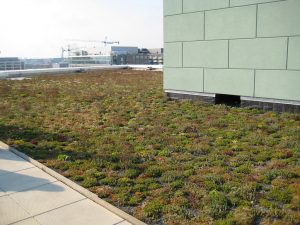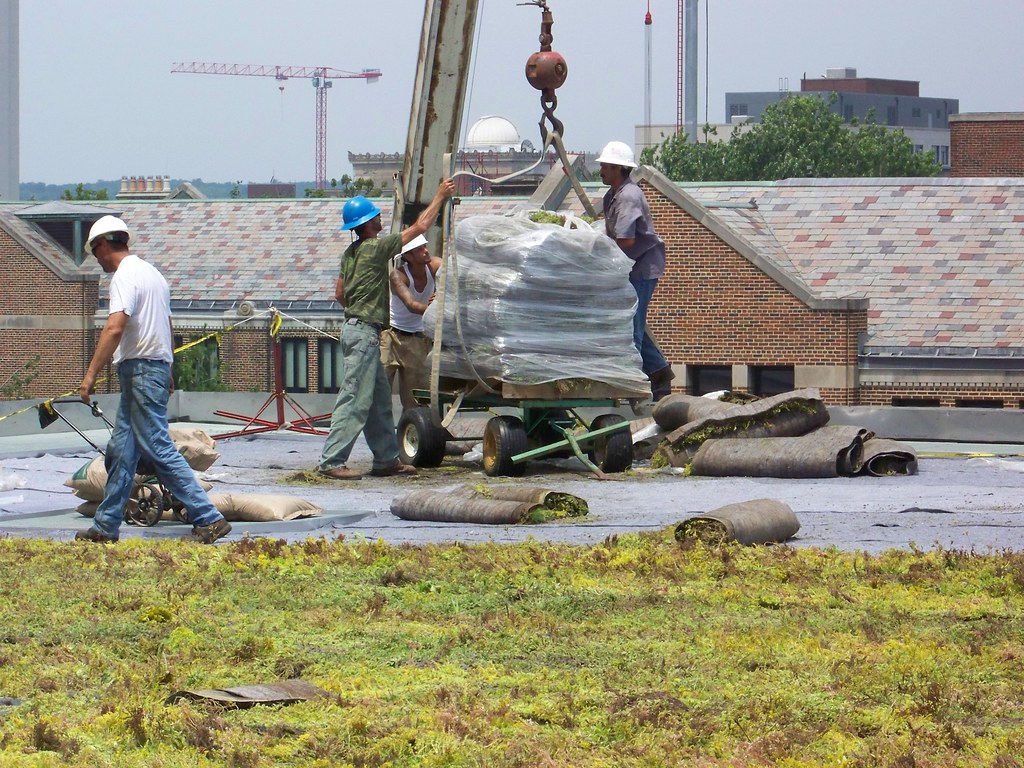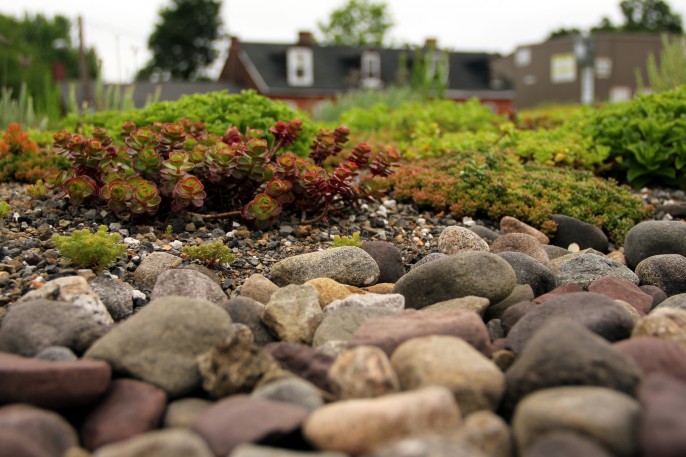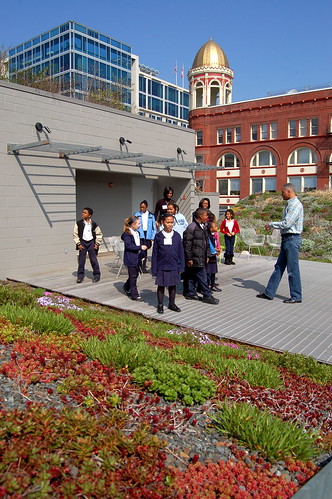Green Roofs
A green roof, or vegetated roof, is a system composed of succulent plants and soils that collect and absorb rain during storm events. They can be installed upon existing rooftops or installed when a traditional rooftop is being replaced, provided the structure is strong enough to carry the additional weight. They are efficient at reducing stormwater pollution, energy consumption, and improving overall air quality, among other benefits. Such benefits can be broken down into two categories, Environmental and Social.
Environmental Benefits
The following benefits of green roofs are taken from DC Greenworks:
- Reduces heating in buildings by adding thermal mass and resistance to the roof membrane; and reduces heat loss and energy use in winter conditions
- Reduces cooling loads on a building by 50 – 90%; again reducing cooling loss and energy use in summer months
- Dramatically reduces the temperature fluctuations on the rooftop daily, seasonally and yearly:
- in the summertime, lower ambient air temperature means HVAC equipment is operating less and with greater efficiency
- in urban areas,a concentration of green roofs can reduce the city’s average temperatures during the summer; known as, the Heat Island Effect, cities are hotter than surrounding areas due to impervious surfaces, such as rooftops, streets, paved parking lots and playgrounds
- Reduces stormwater runoff:
- rainwater is stored by the media, absorbed by the plants, then returned to the atmosphere; in summer 70-90%, is retained; in winter between 25-40%
- green roofs also moderate the temperature of the water that happens to run off, improving water quality for marine life
- green roofs delay the time that runoff occurs, reducing the number and volume of overflows in combined sewer systems (CSOs)
- green roofs slow the velocity of direct runoff, reducing erosion of stream and river banks, and the sedimentation and loss of habitat that result
-

Green roofs are typically composed of sedums, but can also include grasses, flowers and edible plants. Image courtesy: Chesapeake Bay Program
Green roofs reduce noxious and volatile organic compounds (VOCs) from off gassing into the atmosphere by covering asphalt, plastic and other membrane roof surfaces
- Creates natural habitat and promotes biodiversity, including increasing the population of pollinators in cities
- Filters pollutants and carbon dioxide (CO2)out of the air; improving air quality which helps lower rates of diseases, such as asthma; sequestering CO2, reduces the pace of global warming and climate change
- Filters pollutants and heavy metals out of rainwater, keeping waterways and marine life healthy and abundant
- Serves as a sound dampener, insulating a building for noise reduction; the soil blocks lower frequencies and theplants block higher frequencies
- Reduce the space used for landfills; green roofs protect the roof membrane from damage and wear, extending the life of the membrane 2 to 3x, lowering the volume of materials deposited in landfills
- Contribute to achieving several points in multiple LEED credit categories; including Sustainable Sites, Water Efficiency, Material Resources, Environmental Quality and Innovation in Design
- Offer agricultural space, especially in urban areas; contributing to accessible and locally grown produce
Getting A Green Roof
Installing green roofs on residential properties is becoming a more popular trend as people learn the economic and environmental benefits to having them.
There are many opportunities and resources available for the Do It Yourself eco-savvy folks out there, however the structural integrity of the existing roof should always be analyzed by a professional as a first step.

Green Roof Installation at Kresge Library, Ross School of Business at the University of Michigan. Image courtesy of Corey Seeman.
Social Benefits
The following benefits of green roofs are taken from DC Greenworks:
Aesthetic Value
- improves morale and productivity; one study for schools described results of higher grades, as well as improved attendance
- more visually appealing than tar, gravel or plastic membrane roofs, either black or white, especially viewed from above
Amenity Value
- desire for more green space in cities as urbanization increases
- accessible green roofs provide green space above the dim of city streets
- increase marketability of properties; buildings with green roofs command higher lease rates and selling prices
Therapeutic Value
- horticultural therapy has shown improvement of health among aging populations and those with health issues
- faster recovery rates for hospital patients with more natural surroundings
- overall wellbeing is markedly improved with greenery and natural vista
Urban Agriculture
- increases food security and reduces food miles
- fruit and produce availability in urban ‘food deserts’
- opportunity for community building and empowerment
- locally-sourced food for restaurant and hospitality industry
Recreation Value
- rooftop terraces for residents and workers
- space for playgrounds for urban schools and childcare facilities
Job Creation
- growth of the green roof market gives new job opportunities in manufacturing, plant growth, design, installation, and maintenance
- according to American Rivers, a$10B investment could create 190,000 jobs by building 48.5 billion-square-feet of green roof area, or just one percent of the United States’ roof space in every community over 50,000 in population jobs and career opportunities would encompass a wide range of disciplines at all level of skill
Educational Value
- provide an easily accessible site to teach the sciences, from biology and chemistry, to engineering and technology




